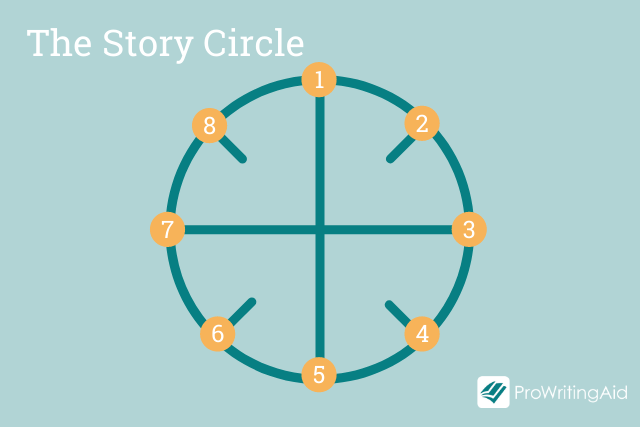
There are many plot structures you can use to help plot your novel, like the Three-Act Structure, Save the Cat, or the Snowflake Method. One of the most famous plot structures was created by Joseph Campbell after identifying that most myths across time and space follow the same general structure. The Hero’s Journey can apply to all sorts of stories.
But the Hero’s Journey is complicated. If you go by Campbell’s structure, there are 17 stages. It was simplified by Christopher Vogler into 11 stages. You might also find that your story really doesn’t fit this pattern.
Dan Harmon, the creator of the show Rick and Morty, simplified the Hero’s Journey even further. His Story Circle, or Story Embryo, can also fit more types of stories that aren’t necessarily about a hero going on a journey and returning to the mundane world.
One of the advantages of the Story Circle is that the narrative structure is so universal, it can apply to books, short stories, TV shows, plays, and movies. It’s a great place to start building the plot of your story. If you’re not much of a plotter, you can identify the main eight pieces and then start writing. Or you can take your story circle and flesh it out into a more detailed outline.
The Story Circle Structure
Draw a circle. Divide it into quarters. Then divide each of those quarters in half. This gives you eight points for your story.

Here are how those eight points work together to build a story:
- A character is in a zone of comfort,
- But they want something.
- They enter an unfamiliar situation,
- Adapt to it,
- Get what they wanted,
- Pay a heavy price for it,
- Then return to their familiar situation,
- Having changed.
Or you can simplify this even further:
- You
- Need
- Go
- Search
- Find
- Take
- Return
- Change
Watch Dan Harmon explain the structure himself, using two episodes of Rick and Morty to explain it, here.
Now, let’s dive into each of these steps in more detail, using a familiar fairy tale: Cinderella.
A Working Example: The Story of Cinderella
Step One
A character is in a zone of comfort. You can equate this to the mundane world in the Hero’s Journey. This is where we meet our character and see what normal is. In a novel, you would use this to establish the setting and introduce all important characters.
In Cinderella, we find out that Cinderella is used for slave labor by her stepmother and stepsisters. She has animal friends, and she is very unhappy with her life although she has a positive attitude.
Step Two
Step two is that your character wants something. This is where the conflict is introduced, as well as the stakes and your characters’ motivations. For more traditional plot language, inciting incidents are included in this step.
Cinderella finds out about the ball, and she wants to go. Her stepmother agrees to let her if she can get all her chores done.
Step Three
The character enters an unfamiliar situation. This is the equivalent of “crossing the threshold” in the Hero’s Journey. The character must make a change, go on an adventure, or otherwise work toward their goal. In a three-act structure, this would be where act one ends and act two begins. It’s the beginning of the rising action.
Cinderella works hard to finish all her chores, and she makes a dress. Her stepmother and stepsisters destroy her dress and don’t allow her to go to the ball.
Step Four
The character adapts to the new situation. You establish the new normal for your character. All rising action that leads to the turning point or climax goes in this step.
Cinderella meets her Fairy Godmother, who gets her ready for the ball with a fancy dress, carriage, and glass slippers. She must leave before midnight when the spell ends.

Step Five
The character finally gets what they wanted! But the story doesn’t end here. This is often the turning point or the climax depending on the story.
Cinderella goes to the ball, dances and falls in love with the prince, and loses her glass slipper as she leaves when the clock strikes midnight.
Step Six
The character got what they wanted, but now they must pay a heavy price for it. This is the “all is lost” stage of your story. Often the climax fits right around here.
Cinderella got her one night of freedom, but now she’s lost her one true love.
Step Seven
The character returns to the familiar situation or mundane world. This is the falling action of a story.
Cinderella is locked away by her stepmother while the prince searches for the girl who fits in the glass slipper.
Step Eight
The character has changed. This is the conclusion or resolution of the story.
Cinderella has tasted love and freedom, so she breaks out and reunites with the prince who saves her. She has changed because she is willing to fight for her right to a happily ever after.
How to Use the Story Circle
Now it’s your turn. See how many stories you know that can fit into this structure to practice. They can be fairy tales, novels, or even movies. Then build your own story circle for your story.
What plotting methods have you used? Let us know in the comments.


